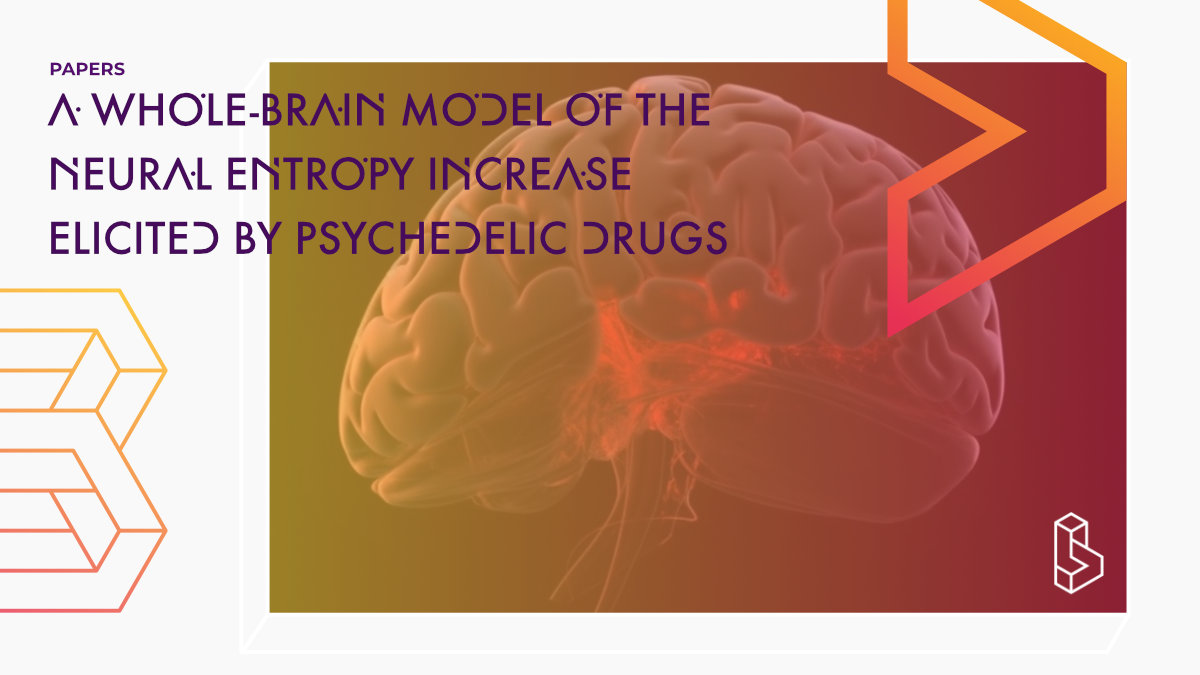This whole-brain simulation reproduces earlier studies where increased entropy was found under the influence of psychedelics. The changes weren’t uniform, with larger effects in the optical area. The changes were not well-explained by looking at where the most serotonin (2a) receptors were but mapped closely to the topological (spatial) properties of how the brain is connected.
Abstract
“Psychedelic drugs, including lysergic acid diethylamide (LSD) and other agonists of the serotonin 2A receptor (5HT2A-R), induce drastic changes in subjective experience, and provide a unique opportunity to study the neurobiological basis of consciousness. One of the most notable neurophysiological signatures of psychedelics, increased entropy in spontaneous neural activity, is thought to be of relevance to the psychedelic experience, mediating both acute alterations in consciousness and long-term effects. However, no clear mechanistic explanation for this entropy increase has been put forward so far. We sought to do this here by building upon a recent whole-brain model of serotonergic neuromodulation, to study the entropic effects of 5HT2A-R activation. Our results reproduce the overall entropy increase observed in previous experiments in vivo, providing the first model-based explanation for this phenomenon. We also found that entropy changes were not uniform across the brain: entropy increased in all regions, but the larger effect were localised in visuo-occipital regions. Interestingly, at the whole-brain level, this reconfiguration was not well explained by 5HT2A-R density, but related closely to the topological properties of the brain’s anatomical connectivity. These results help us understand the mechanisms underlying the psychedelic state and, more generally, the pharmacological modulation of whole-brain activity.”
Authors: Rubén Herzog, Pedro A. M. Mediano, Fernando E. Rosas, Paul Lodder, Robin Carhart-Harris, Yonatan Sanz Perl, Enzo Tagliazucchi & Rodrigo Cofre
The previous version of this article was retracted. In a sign of a healthy scientific climate, the person who discovered the error is now a co-author of the updated analysis.
Summary of A whole-brain model of the neural entropy increase elicited by psychedelic drugs
Psychedelic drugs provide a privileged opportunity to study the mind-brain relationship and may revolutionise some of our current mental health treatments.
Serotonergic psychedelics (including LSD, DMT and psilocybin) potentially modulate mood, cognition, perception and self-awareness. At a neurophysiological level, recent research has identified two particularly prominent signatures of the psychedelic state: an overall dysregulation of neural population activity and an increase in the signal diversity of the neural activity.
Based on these findings, Carhart-Harris and colleagues have put forward the Entropic Brain Hypothesis (EBH), which proposes that the richness of subjective experience is directly related to the richness of ongoing neural activity. The EBH also proposes that the topographic distribution of serotonin 2A receptors is critical to reproduce the functional connectivity dynamics of LSD.
Find this paper
A whole-brain model of the neural entropy increase elicited by psychedelic drugs
https://doi.org/10.1038/s41598-023-32649-7
Open Access | Google Scholar | Backup | 🕊
Authors
Authors associated with this publication with profiles on Blossom
Robin Carhart-HarrisDr. Robin Carhart-Harris is the Founding Director of the Neuroscape Psychedelics Division at UCSF. Previously he led the Psychedelic group at Imperial College London.
Enzo Tagliazucchi
Enzo Tagliazucchi is the head of the Consciousness, Culture and Complexity Group at the Buenos Aires University, a Professor of Neuroscience at the Favaloro University, and a Marie Curie fellow at the Brain and Spine Institute in Paris. His main interest is the study of human consciousness as embedded within society and culture.
Fernando Rosas
Dr. Fernando E. Rosas is a Postdoctoral Researcher at Imperial College London, based at the Centre For Psychedelic Research.
Linked Research Papers
Notable research papers that build on or are influenced by this paper
[RETRACTED] A mechanistic model of the neural entropy increase elicited by psychedelic drugsThis whole-brain simulation study (DMF model) reproduced increased entropy under psychedelics, but also found this to be different (higher/lower) in various parts of the brain, this was correlated with the connections between brain regions, not serotonin (5-HT2a) receptor density.

